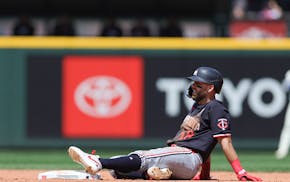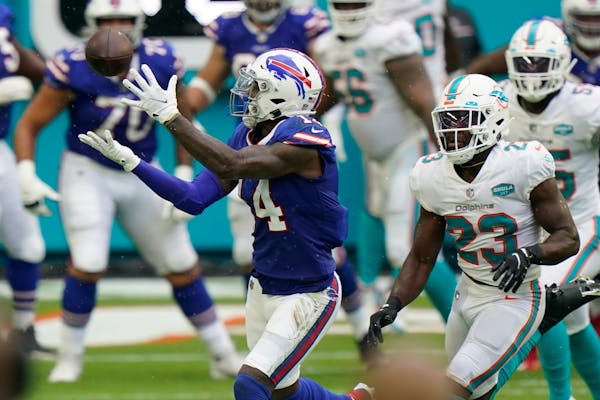The NFL didn't keep individual stats until 1932, its 13th season. It would be another 10 seasons before someone would tip the scales to a weight never seen in an official single-season rushing champion.
Clarence "Pug" Manders, a farm-strong South Dakotan, was playing fullback for the Brooklyn Dodgers when his 1941 team bio read, "Manders is the nearest thing to a pile driver in the NFL today. He weighs 205 pounds … and hits with hurricane velocity."
The official weight for this 6-foot beast was actually 200 pounds.
Fast forward 79 years to U.S. Bank Stadium, where the Vikings on Sunday will face Tennessee's 6-3, 247-pound Derrick Henry, last year's rushing champion with 1,540 yards on 303 carries in 15 games.
In the 88-year history of crowning NFL rushing champions, only former Chiefs running back Christian Okoye, the "Nigerian Nightmare," was heavier than Henry at 6-1, 253 pounds. Henry and Eric Dickerson are the tallest at 6-3.
If you include the AFL years, Buffalo's two-time rushing champ Cookie Gilchrist was especially giant for the early 1960s. He was 6-3, 251 pounds, and mean to boot.
To say Henry is a load doesn't quite do him justice. About five decades ago, the best defensive line in football included a 245-pound Alan Page, a 247-pound Carl Eller and a 248-pound Jim Marshall.
"It's important to make sure you don't try hit him and truck stick him," Vikings linebacker Eric Wilson said.
That would not be advisable one-on-one in the open field. Not when the Vikings' top two healthy linebackers are the 6-1, 230-pound Wilson and the 6-0, 232-pound Eric Kendricks. And, while we're at it, even Vikings defensive end Yannick Ngakoue is smaller than Henry at 6-2, 246.
"If he's 20 pounds heavier," Wilson said, "that means you have to get some leverage. … And we also have to have more than one person tackling him. We have to have guys swarm to the ball."
Vikings coach Mike Zimmer was asked to name the best big back he's had to prepare for in his 27 seasons in the NFL.
"Jerome Bettis was pretty good," he said of the 5-11, 252-pound Steelers Hall of Famer.
The knock on Bettis during the Hall of Fame voting process was his 3.9-yard average per carry. But he couldn't help it that goal lines kept ending his carries far short of 4 yards.
In a 24-21 win over Oakland in 2004, Bettis' stat line read: five carries, 1 yard, three touchdowns. No one stopped "The Bus" on the goal line. Just ask Brian Urlacher.
Bettis probably had the quickest feet of any big back. Henry has a long way to go to belong in the same sentence, but he does have better speed to the outside.
"He's big, physical, good in pass protection, and not everybody's good at those," Zimmer said. "He's good in screens. I feel like he's one of those guys that's always going to fall forward and continue to get good yards. Good vision, good feet, good acceleration."
Including playoffs, Henry has topped 100 yards rushing eight times in his past 11 games, including 116 in the season-opening win over Denver. While setting records last season, he became the first player in NFL history to top 180-yard rushing in three straight games.
All were on the road. When the Titans needed to win to secure the No. 6 seed in the AFC, he ran for 211 yards at Houston. Then he helped Tennessee post two stunning playoff upsets with 182 yards against the Patriots and 195 against Baltimore.
Last week, Jacksonville was hailed for holding Henry to 84 yards on 25 carries in a 33-30 loss to Tennessee. But Henry's impact still was felt from the game's first snap, when Tennessee completed a 62-yard pass off a play-action fake to Henry.
A red-zone touchdown pass came off the same look. And, of course, there was the third-and-3 from the Jacksonville 17. With eight defenders in the box, Henry ran up the middle and basically fell forward 7 yards.
"Yeah, Derrick Henry is a big back," Wilson said. "And they're going to give him the ball."
Mark Craig is an NFL and
Vikings Insider.
Twitter: @markcraigNFL.

Souhan: Will the Timberwolves trade for Kevin Durant? Should they?

Lynx improve to 7-0 with strong second half vs. expansion Valkyries

Twins lose in walk-off against Seattle for second straight game
Three-goal outburst in second half helps Minnesota United to rare victory in Seattle


